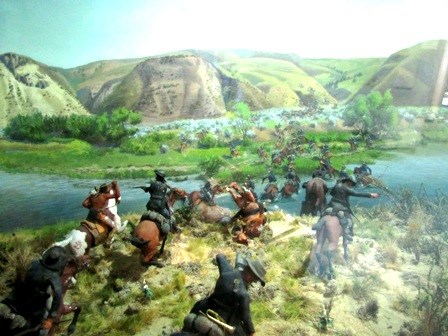
Marcus Reno was born on November 15, 1834, in Carrollton, Illinois. Reno entered West Point on 1 September 1851. Reno graduated 20th in a class of 38 in June 1857. Reno served in the Union Army during the Civil War, participating in the Battles of Kelly's Ford (wounded), the Gettysburg Campaign, Cold Harbor, Trevilian Station, and Cedar Creek. He was twice brevetted for gallant and meritorius conduct. 
NPS photo Reno at Little BighornOn June 25, Custer's Crow scouts located the village of Lakota and Cheyenne, estimated today at over 8,000 individuals, with 1,500-2,000 warriors. As the 7th Cavalry approached the Little Bighorn River, Reno was directed to take three companies and cross the river and attack the village from the south. Custer told Reno he would support him with the "whole outfit." As Reno approached the village, hundreds of warriors responded to meet him. Reno called a halt, had his men dismount and form into a skirmish line. After a short time Reno's skirmish line was flanked and he fell back to the woods along the river.For a time, Reno's battalion held out in the woods as the Indian warriors surrounded the soldiers. When the Lakotas and Cheyennes fighting him began to infiltrate the woods, Reno decided his defensive position was untenable. At that time, Arikara scout Bloody Knife was shot in the head while Reno tried to communicate with him, covering Reno with brain matter and blood, and causing Reno to act erratically. Reno mounted his troops and led them in a headlong charge that became a retreat and then a mad run for life to the bluffs across the river. Some men from Company G were left in the woods; those that left late were killed, those that stayed in the woods eventually made it back to Reno's defensive position across the river. Soon the Indian defenders left Reno's front to respond to Custer's threat further down river. Shortly before this, Captain Benteen's battalion of three companies arrived at Reno's position in response to Custer's comminque. Reno rushed out to Benteen and said, "For God's sake, Benteen, halt your command and help me! I've lost half my men!" In the meantime, firing was heard down river, and Captain Weir sought Reno's permission to move Company D towards the sound of the firing. Eventually, the pack train came up and, with the wounded, Reno attempted to move the command to follow Weir. The Lakota and Cheyenne warriors responded to the soldiers' appearance on the high ground to the south and forced Reno back to his original position on the bluffs. Into the next day (June 26) the remainder of the 7th Cavalry commanded by Reno and Benteen held out under heavy fire from the Indian warriors. With the approach of General Terry's column, the warriors broke off the siege of Reno's position and the great village moved off to the south. Reno's men learned of Custer's fate from Terry's column on June 27. AftermathAfter learning the fate of Custer's battalion, the men under Reno's command were grateful for their survival. However, shortly after the battle Reno came under considerable criticism from disparate elements both within, and outside the army. Reno was accused of not prosecuting the attack on the village as ordered, and of not coming to Custer's support.Though Reno's actions at the Little Bighorn were never officially criticized by the army command, he called for a Court of Inquiry into his actions at the battle to officially exonerate his name. On February 10, 1879, after extensive interrogation of the officers and civilians present at the battle, the court concluded the following: "…while subordinates in some instances did more for the safety of the command by brilliant displays of courage than did Major Reno, there is nothing in his conduct which required [adverse criticism] from the Court." Ultimately, the criticism of his conduct at Little Bighorn was only one element which conspired to end Reno's military career. After the death of his wife in 1874, Reno descended into alcoholism. Altercations with fellow officers and inappropriate advances towards women initially resulted in a two year suspension from the army. He was eventually dismissed from the army, effective April 1, 1880. Marcus Reno unsuccessfully sought reinstatement into the army for many years. He died on March 30, 1889 at the age of 54. More than seventy years later, a reinvestigation into Reno's role at the Battle of the Little Bighorn concluded that he had done nothing to warrant the criticism directed against him. His family members asked to have Reno's remains buried in the Custer National Cemetery, which was granted and which resulted in Reno's remains being buried on September 9, 1967. Marcus Reno is the highest ranked soldier buried in Custer National Cemetery. Learn more: "In Custer's Shadow: Major Marcus Reno" by Ronald H. Nichols (University of Oklahoma Press, 2000), "Marcus Reno in the Valley of the Little Big Horn: Limited Means, Excessive Aims" by Frederic C. Wagner III (McFarland, 2021) |
Last updated: April 23, 2025
